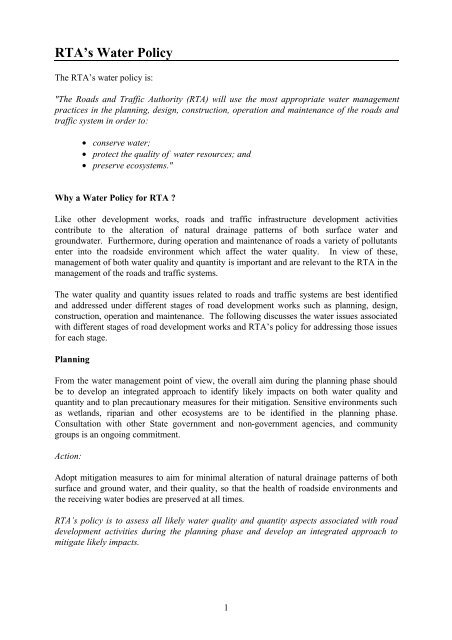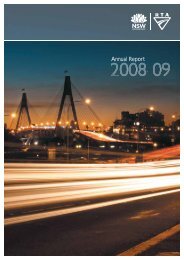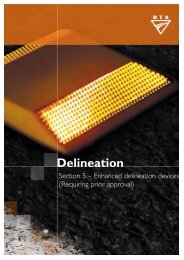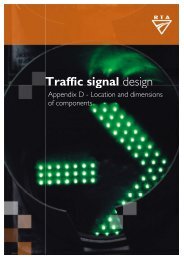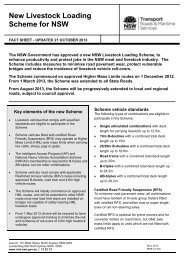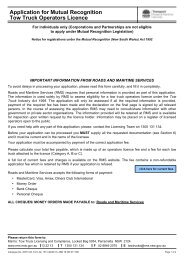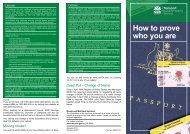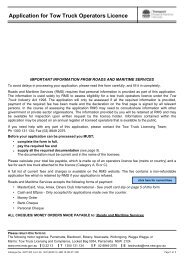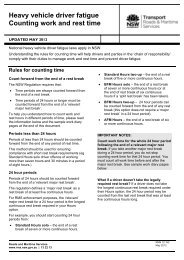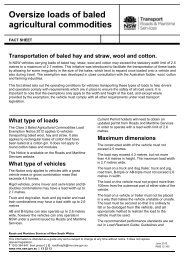RTA's water policy
RTA's water policy
RTA's water policy
You also want an ePaper? Increase the reach of your titles
YUMPU automatically turns print PDFs into web optimized ePapers that Google loves.
RTA’s Water Policy<br />
The RTA’s <strong>water</strong> <strong>policy</strong> is:<br />
"The Roads and Traffic Authority (RTA) will use the most appropriate <strong>water</strong> management<br />
practices in the planning, design, construction, operation and maintenance of the roads and<br />
traffic system in order to:<br />
• conserve <strong>water</strong>;<br />
• protect the quality of <strong>water</strong> resources; and<br />
• preserve ecosystems."<br />
Why a Water Policy for RTA ?<br />
Like other development works, roads and traffic infrastructure development activities<br />
contribute to the alteration of natural drainage patterns of both surface <strong>water</strong> and<br />
ground<strong>water</strong>. Furthermore, during operation and maintenance of roads a variety of pollutants<br />
enter into the roadside environment which affect the <strong>water</strong> quality. In view of these,<br />
management of both <strong>water</strong> quality and quantity is important and are relevant to the RTA in the<br />
management of the roads and traffic systems.<br />
The <strong>water</strong> quality and quantity issues related to roads and traffic systems are best identified<br />
and addressed under different stages of road development works such as planning, design,<br />
construction, operation and maintenance. The following discusses the <strong>water</strong> issues associated<br />
with different stages of road development works and RTA’s <strong>policy</strong> for addressing those issues<br />
for each stage.<br />
Planning<br />
From the <strong>water</strong> management point of view, the overall aim during the planning phase should<br />
be to develop an integrated approach to identify likely impacts on both <strong>water</strong> quality and<br />
quantity and to plan precautionary measures for their mitigation. Sensitive environments such<br />
as wetlands, riparian and other ecosystems are to be identified in the planning phase.<br />
Consultation with other State government and non-government agencies, and community<br />
groups is an ongoing commitment.<br />
Action:<br />
Adopt mitigation measures to aim for minimal alteration of natural drainage patterns of both<br />
surface and ground <strong>water</strong>, and their quality, so that the health of roadside environments and<br />
the receiving <strong>water</strong> bodies are preserved at all times.<br />
RTA’s <strong>policy</strong> is to assess all likely <strong>water</strong> quality and quantity aspects associated with road<br />
development activities during the planning phase and develop an integrated approach to<br />
mitigate likely impacts.<br />
1
Design<br />
Road design plays an important role in determining both the short and long-term <strong>water</strong> quality<br />
and quantity aspects of road run-off. In order to address these <strong>water</strong> issues new road design<br />
concepts which are “environmentally friendly” should continue to be investigated, developed<br />
and implemented. Some of these design features include edge-drain systems, porous<br />
pavements, drainage through created wetlands, grass swales, detention basins and median<br />
strips. These features retard roadside surface flows as well as retaining road run-off<br />
pollutants.<br />
Action:<br />
Adopt road design principles to maintain existing surface and ground<strong>water</strong> flows and<br />
incorporate containment structures to contain and treat road run-off to protect<br />
environmentally sensitive areas, where necessary.<br />
RTA’s <strong>policy</strong> is to design roads to ensure that the existing natural overland flows and the<br />
ground<strong>water</strong> regimes in and around road corridors are either retained or will have only<br />
minimum alterations. Appropriate technologies to contain and treat run-off to avoid or<br />
minimise impacts on sensitive aquatic environments are to be incorporated in the road<br />
design.<br />
Construction<br />
During road construction, there is potential for the <strong>water</strong> quality in and around construction<br />
corridors and/or sites to deteriorate, mainly due to uncontrolled erosion and sedimentation. In<br />
addition, there is the potential to pollute soil and <strong>water</strong> from accidental spillage of road<br />
construction materials, leakage or spillage of fuels, lubricating and hydraulic oils from<br />
construction equipment. Further, wash-<strong>water</strong> run-off from construction equipment could<br />
contaminate soil and <strong>water</strong> during construction.<br />
Action:<br />
Appropriate best management control measures are to be implemented to mitigate potential<br />
deleterious effects on both <strong>water</strong> quality and quantity in all areas of construction sites.<br />
RTA’s <strong>policy</strong> is to implement effective <strong>water</strong> management practices and procedures as an<br />
integral part of on-site construction management to ensure that <strong>water</strong> quality and quantity<br />
impacts on the environment are minimised.<br />
Operation<br />
Operation of roads leads to build up of contaminants on road surfaces, median areas and<br />
roadside corridors. During rain events these contaminants, depending on their physical and<br />
chemical properties, are transported by road run-off into surrounding <strong>water</strong> bodies. In order<br />
to minimise the impact of such contaminants on the surrounding environment innovative<br />
structural and non-structural measures capable of controlling road run-off pollutants are to<br />
implemented by the RTA.<br />
2
Action:<br />
Structural measures such as detention basins, gross pollutant traps, grass channels and created<br />
wetlands need to be maintained. Non-structural measures such as community involvement in<br />
reducing roadside litter and developing an ownership for good vehicle maintenance practices<br />
need to be encouraged and implemented to prevent pollution at the source.<br />
RTA’s <strong>policy</strong> is to develop and maintain both structural and non-structural measures to<br />
minimise <strong>water</strong> pollution during operation of roads.<br />
Maintenance Works<br />
Activities related to road maintenance have the potential to discharge pollutants into the<br />
surrounding environment. Some of these activities include road and bridge maintenance<br />
works, operation of maintenance depots and use of herbicides for roadside weed control.<br />
These activities, depending on their nature and proximity to <strong>water</strong> courses, have the potential<br />
to discharge pollutants either directly or indirectly into nearby creeks, rivers and lakes etc.<br />
Action:<br />
On-site control measures together with adherence to good work practices need to be<br />
developed and implemented to ensure minimum discharge of pollutants originating from all<br />
maintenance works.<br />
RTA’s <strong>policy</strong> is to identify potential <strong>water</strong> pollution issues related to all RTA maintenance<br />
activities and to ensure that those activities are performed in an enviromentally responsible<br />
manner to avoid and/or minimise impacts on receiving <strong>water</strong> bodies and associated aquatic<br />
ecosystems.<br />
Water Conservation<br />
The RTA, through its <strong>water</strong> <strong>policy</strong>, is committed to instituting <strong>water</strong> conservation initiatives,<br />
where feasible, as a resource conservation measure. Some RTA activities, especially road<br />
construction and maintenance works, involve work practices which utilise large volumes of<br />
potable <strong>water</strong>. In addition, potable <strong>water</strong> is used to enhance or maintain roadside vegetation,<br />
particularly during drought periods.<br />
Action:<br />
Water efficient work practices, such as <strong>water</strong> reuse, recycling and the use of treated effluent<br />
for roadside irrigation, and road construction and maintenance works need to be investigated.<br />
These should be implemented when cost or environmental benefits are identified.<br />
RTA’s <strong>policy</strong> is to implement appropriate <strong>water</strong> conservation practices and principles to<br />
reduce potable <strong>water</strong> usage and to encourage use of storm<strong>water</strong> and treated waste<strong>water</strong> in all<br />
RTA activities.<br />
3


